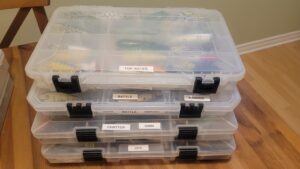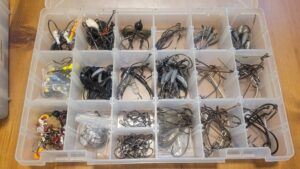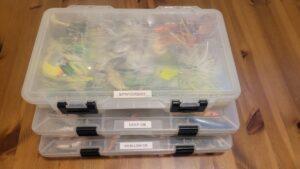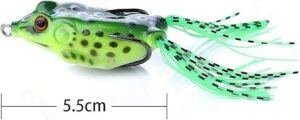Tackle Storage: Organized For Easy Access
Introduction
Fishing is not just about casting your line and hoping for a bite; it’s about preparation, strategy, and having the right tools at your disposal. One crucial aspect of successful fishing is having organized tackle storage. Whether you’re a seasoned angler or just starting out, having your tackle neatly organized and easily accessible can make a world of difference in your fishing experience.
In this comprehensive guide, we’ll delve into the intricacies of tackle storage, from selecting the right storage system to organizing your tackle effectively for easy access. We’ll explore various storage options, discuss tips and tricks for maintaining organization, and provide insights into maximizing efficiency while fishing.
The Basics of Tackle Storage
Before we dive into the nitty-gritty details of tackle organization, let’s first understand why it’s so important. Tackle encompasses a wide range of fishing gear, including lures, hooks, lines, sinkers, and more. Proper storage not only helps protect your tackle from damage but also ensures that you can quickly locate the right gear when you need it most.
Disorganized tackle storage can lead to frustration and wasted time on the water. Imagine digging through a cluttered tackle box in search of a specific lure while the fish are biting – it’s a scenario every angler dreads. By keeping your tackle neatly organized, you can streamline your fishing experience and focus on what matters most: catching fish.
Choosing the Right Tackle Storage System
With countless tackle storage options available on the market, selecting the right system can seem overwhelming. However, by considering factors such as size, durability, and portability, you can narrow down your choices and find the perfect storage solution for your needs.
Traditional tackle boxes are a popular choice among anglers due to their versatility and compartmentalized design. These boxes typically feature multiple trays and compartments for organizing tackle by type and size. Alternatively, tackle bags offer a more portable option, with removable trays and pockets for storing gear. For anglers with extensive tackle collections, larger storage solutions such as tackle stations or tackle backpacks provide ample space for organizing gear.
When choosing a tackle storage system, it’s essential to consider your fishing style and the environments in which you’ll be fishing. If you primarily fish from a boat, a waterproof tackle box or bag may be ideal for protecting your gear from the elements. Shore anglers, on the other hand, may prefer a more compact and lightweight storage solution that can be easily transported to their fishing spot.
Organizing Your Tackle
Once you’ve selected the right tackle storage system, the next step is to organize your tackle effectively. Proper organization not only makes it easier to find the gear you need but also helps prolong the life of your tackle by preventing tangles and damage.
Start by sorting your tackle into categories based on type and purpose. Separate your lures, hooks, lines, and other gear into distinct groups to make it easier to locate specific items when fishing. Utilize compartmentalization and dividers within your storage system to keep tackle neatly separated and prevent tangling.
Labeling and categorizing your tackle can further streamline the organization process. Consider using labels or color-coding systems to identify different types of tackle quickly. For example, you might use red labels for crankbaits, blue labels for soft plastics, and green labels for terminal tackle. In the bass fishing world you could organize your tackle by the fishing technique such as, Deep Diving Crankbaits, Swim Jigs, Lipless Crankbaits, Spinnerbaits, etc, this way when you are on the water you can find your lures by a fishing technique that saves time when the fish are biting. By labeling your tackle, you can quickly locate the gear you need without wasting time searching through each compartment.

In addition to traditional tackle storage solutions, there are also innovative options available for organizing your gear. Tackle management apps, for example, allow anglers to catalog their tackle collections digitally and access them on their smartphones or tablets. RFID (Radio Frequency Identification) tags can also be used to track and locate specific items within your tackle box or bag.
Accessorizing Your Tackle Storage
To further enhance the functionality of your tackle storage system, consider adding extra features and accessories. Utility boxes, for example, provide additional storage space for small items such as weights, swivels, and hooks. Tool holders can keep essential fishing tools such as pliers and scissors within easy reach.
Many tackle storage systems also feature built-in innovations designed to maximize convenience and efficiency. Some tackle boxes include integrated LED lights for fishing at night, while others feature built-in rod holders for securing your fishing rods while on the water. By accessorizing your tackle storage system, you can customize it to meet your specific needs and preferences.
DIY enthusiasts can also get creative with their tackle storage solutions. Repurposing household items such as pill organizers, ice cube trays, accordion file folders and tackle trays can provide inexpensive yet effective ways to organize small tackle items. PVC pipe can be used to create custom rod holders, while pegboard or corkboard mounted to the wall can serve as a versatile storage solution for larger items such as fishing rods and nets.


Tips for Efficient Tackle Access
Once you’ve organized your tackle storage system, it’s essential to establish a system for efficient tackle access while fishing. Position your tackle storage within easy reach on your boat or shore fishing setup to minimize time spent searching for gear. Consider using a tackle bag with shoulder straps for hands-free access while wading or bank fishing.
Establishing a logical layout within your tackle storage system can also help streamline tackle access. Arrange your tackle in the order of frequency of use, with commonly used items placed within easy reach and less frequently used items stored in secondary compartments. By organizing your tackle strategically, you can minimize the time spent searching for gear and maximize your time spent fishing.
Staying organized while fishing requires discipline and consistency. Make it a habit to return each piece of tackle to its designated storage compartment after use. Resist the temptation to toss gear haphazardly into your tackle box or bag, as this can lead to tangles and damage. By maintaining a tidy and organized tackle storage system, you can ensure that your gear remains in top condition and ready for action whenever you hit the water.
Maintaining and Updating Your Tackle Storage System
As your tackle collection grows and evolves, it’s essential to periodically assess and update your tackle storage system. Regular maintenance routines, such as cleaning and inspecting your tackle boxes and bags, can help prolong their lifespan and prevent damage to your gear. Replace worn-out or damaged storage containers as needed to ensure that your tackle remains adequately protected.
Keep track of changes in your fishing habits and tackle preferences, and adjust your storage system accordingly. If you find yourself using certain types of tackle more frequently, consider allocating additional storage space for those items. Similarly, if you discover new fishing techniques or acquire new gear, make adjustments to your storage system to accommodate these changes.
Staying adaptable and open to new storage solutions is key to maintaining an efficient tackle storage system. Don’t be afraid to experiment with different storage options or organizational strategies until you find what works best for you. By staying proactive and attentive to the needs of your tackle collection, you can ensure that your gear remains organized and easily accessible for many fishing adventures to come.
Conclusion
Organized tackle storage is essential for any angler looking to maximize efficiency and enjoyment while fishing. By selecting the right tackle storage system, organizing your gear effectively, and implementing strategies for efficient tackle access, you can streamline your fishing experience and spend more time focusing on the thrill of the catch.
Whether you prefer a traditional tackle box, a modern tackle bag, or a DIY storage solution, the key is to find what works best for your needs and preferences. With proper organization and maintenance, your tackle storage system can become a valuable asset that enhances your fishing success and enjoyment for years to come. So, invest the time and effort into organizing your tackle today, and reap the rewards on your next fishing adventure.



